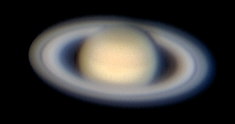
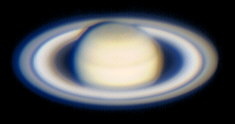
First Light with a Celestron CGE 1400
(Initial impressions regarding a newly acquired C14 on a CGE Mount)
OK, I've just had my first night out with the "hippo", 24th to 25th February 2004; some 5 hours of assembling it on the roof, reading the instruction manual, aligning it, etc and finally trying to image Saturn and Jupiter with it. To make it more interesting I also imaged the same planets with a Celestron Ultima 2000-8", basically a C8/C14 comparo. This C8 is my reference point and I will compare the two scopes accordingly. Here are my initial impressions, subject to change, of course!
I had assembled the scope earlier in the family room and immediately learnt that it's heavy! The C14 OTA (optical tube assembly) weighs about 20kg, and you have to lift it up to head height to put it onto the CGE Mount. You'd better be a big fella if you wish to do that routinely on your own and still do no injury to yourself or to the OTA! The CGE Mount also weighs around 20kg. To balance the OTA you need another 20kg of counterweights. And finally there's the tripod, a bit lighter, but still quite heavy. I decided that I was not going to assemble and take down that lot every night! So I ran off to our local car upholsterer and got him to make me a cover for the scope, out of some material normally used for car covers. From previous experience I learnt that any such cover should be very loose and baggy, otherwise you run the risk of rubbing off eyepiece covers or knocking the scope out of alignment. So I asked him to make me an ample-sized bag. I was ready for the roof as soon as he had it ready.
Instruction book in hand, I ventured to align the scope. Well, with some bodily contortions. You see, it's difficult to decide how high you should set the tripod. I set it at what I thought was a low height suited to sit-down observing. Adjusting the legs to get the spirit level roughly OK is not as easy as one expects. See, you are manhandling some 70 to 80 kg above you as you fiddle with the leg lengths. That OTA is also quite big! Next thing was to align the finderscope to the OTA. Picked something terrestrial on the horizon. Finderscope too high, had to stand on a chair :-( Next I wanted to be roughly polar-aligned to begin with, i.e. with Polaris right at the cross-hairs. No need to make things difficult. Let's start things on the right "footing". Polaris is at 23.5 degrees elevation around here, yes, just a few km to the Tropic of Cancer. Had to get back on the chair, climb down, move tripod, back on the chair, etc. The finderscope is located at about 10 or 11 o'clock on the OTA. Might have been better located at 4 or 5 o'clock... Excruciating to view anything near the zenith without a diagonal (I prefer to image without a diagonal and for rough focus I use an eyepiece that's parfocal with my webcam). Had to kneel on the floor... I finally got around to execute the alignment instructions. Scope picked Sirius and swung to it. All that rough polar alignment paid off. Sirius was right in the finderscope :-) Aligned it with a 10mm reticle eyepiece (390x magnification!). I have never seen Sirius this bright! Gobs of diffraction rings, demonstrating excellent collimation, right out of the box :-) Continued with "calibration" and following the scope's polar-alignment routine. Asked the scope to slew to Saturn. It put Saturn right in the field of the 40mm packaged eyepiece. Not a very good eyepiece by the way. Shows quite a bit of light scatter, but nevertheless sharp. 40mm is the low power eyepiece for this scope, but at f11 it's still around 100x magnification! Saturn looked magnificently sharp. Jacked up the power to 560x and things no longer looked sharp. Actually quite poor seeing, hazy and dusty. Saturn looked best at up to around 325x, way superior to any view I've ever had through the C8. One objective I had in acquiring a C14 was so that for planetary viewing and imaging I would be seeing-limited, rather than aperture-inches-limited (diffraction-limited) on most nights. This turns out to be true, though it became apparent in an unexpected fashion. When I looked at the Trapezium in Orion at "low" powers (200 to 300x) one could clearly see the 5th star and just perceive the presence of the sixth. Jack up to 560x and the Trap dropped down to only 4 stars!? Now I'll start getting obsessive about seeing. Unfortunately a concrete roof with numerous air-conditioners spewing out hot air is not the ideal location, but this was never an issue with the C8.
Another observation is that the tracking is so much better than with the Ultima 2000. No planet chasing anymore. Even when Jupiter filled up most of the webcam CCD, it stayed there. With the Ultima at similar magnification (C8 at f50 yields a roughly similar planet size on the CCD as the C14 with a 2x Barlow) it was a constant battle to keep the planet on-chip. Very nice. Both Saturn and Jupiter showed much more detail visually than I had ever seen in the C8. Trouble is, imaging brings a different set of issues. I only had time to take single 90-second videos on each of Saturn and Jupiter, in the C14 and the C8, both with a 2x Barlow. Unfortunately with the fairly mediocre seeing the C14 images were not superior to the C8 ones. NB Visually the planets looked much better in the C14, but normally webcam imaging shows much more detail than is visible by eye. Here are the processed images, I made them roughly the same size to facilitate comparison, C8 on the left, C14 on the right:


Frankly, I feel that the above size is too big for the seeing, even though it's my normal web-presentation size for the C8; below are half-sized versions, to make them look sharper ;-) Actually closer to a view through the eyepiece:


The C8 is capable of rendering Saturn better, at the same roof location, as can be seen here. Next, here's Jupiter, again C8 on the left:

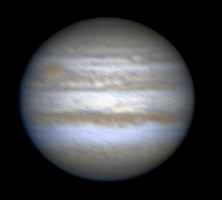
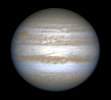
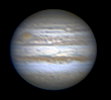
So do inches matter? Aperture inches that is. Visually yes. Pretty obvious actually. So I still believe that both scopes were in good collimation. But the lousy seeing does seem to clobber the larger scope to a greater extent. I'll have to repeat the comparo on another night, when there's more time for careful focusing and more attempts to get it just right. Here's the set-up I was using:
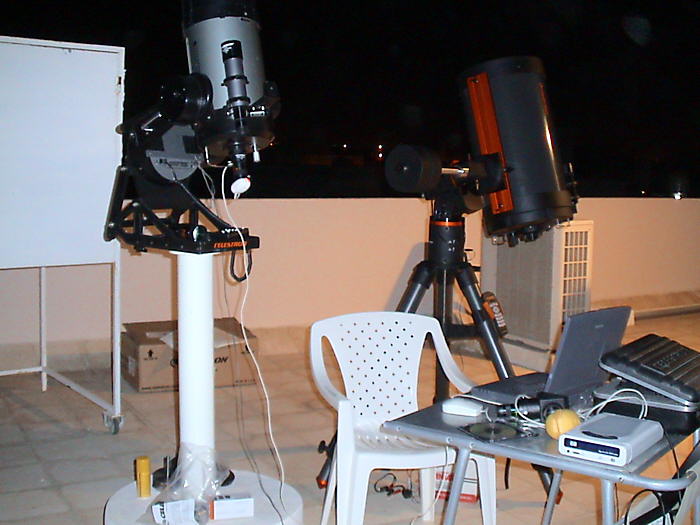
Right, I'll also have to get my metal-banger friend to make me a pier for that C14, once I am sure about the height and where exactly to locate it. Here's the set-up in daytime. See the sources of my light pollution woes, all those neighbors! and that's the dust haze I had to contend with at night. You can barely perceive the nearby mountains at the right side of the picture. The mountains actually extend right across the frame and are well under 10km distant :-( Blue sky is not an issue around these parts. We seldom have cloudy weather but heat haze and dust from far-away sandstorms are a constant annoyance.
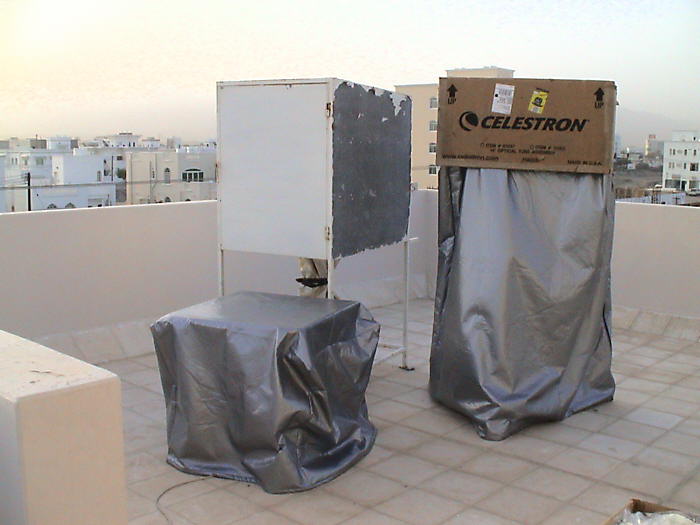
The combination of a dust bag enclosing the scope, covered by a rolling sun/rain shade seems to have worked very well for the C8. Now I am talking to another metal banger (sheet metal this time) to make me a similar one for the C14. Trouble is, it has to be so big it cannot be carried up via the stairs. Trying to convince him to precut and to come to weld the lot on-site ;-) In the meantime the carton serves as a sun shade. Not much rain around these parts ;-)
Tried the C14 on Jupiter again on 28/29th February. Seeing was even worse. Did I mention that I'll now be getting obsessive about this? Anyway made a couple of attempts and gave up. Caught the other side of Jupiter, together with its moon Io. Here is the result:
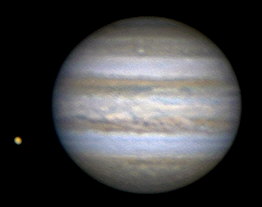
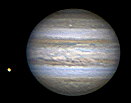
Slightly better seeing on 02 March 2004. At least I think that for the first time I get to see detail within the Great Red Spot. Not too long ago I had trouble even capturing the GRS at all in a DSLR. Hail to the webcams:
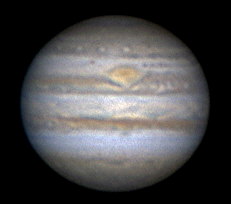

So easy to make things look sharp when you shrink them, eh? Awaiting that night of perfect seeing ;-) And still learning how to process the C14 videos...
More early impressions on the CGE; storage, autoguiding, etc. here
For other stuff click here.